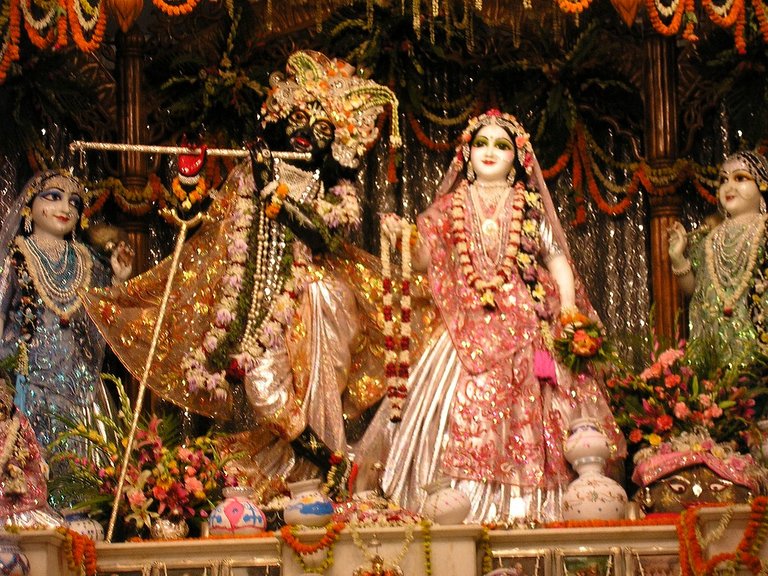
Before we can understand whether God is male or female, we need to understand that we are neither male nor female, but are, at core, spiritual beings
Her Grace Suvarna Radhika Devi Dasi
On Monday, 17 September, Hare Krishna Melbourne celebrated Radhastami, the divine appearance day of the universal mother, Srimati Radharani. Over 1,500 visitors enjoyed the beautifully darshan—devotees had worked hard overnight to hand make dresses for the Lord made completely out of flowers! After bathing Srimati Radharani and Lord Krishna with flowers, and joyously singing their glories in kirtan for over three hours, guests and members enjoyed a sumptuous feast. The cooks had exceeded themselves to create a celebration like none other!
In Vedic tradition, Goddess or Shakti is equally celebrated in her many forms. Yet the general (mis)conception remains that God is male. But the fact is that God is neither—and is both.
Before we can understand whether God is male or female, we need to clearly understand that we ourselves are neither male nor female. We are at core spiritual beings, souls, whereas our gender refers only to our shell, our physical bodies. Our spiritual identity is eternal, our gender is transient. A male can be re-born as female and vice-versa so thinking of ourselves as either is only temporary mis-identification. So in the conventional sense of the words ‘male’ and ‘female’ where these refer to bodily gender, God is neither.
Yet God is both too—as seen in the worship of Divine Couples in the Vedic tradition. To think of God as a light, or formless entity is the lowest level of God realisation. It is like seeing the President’s car convoy pass by and identify the president only as the car. The next level is to understand God as a controller, creator, Supersoul in the heart and so forth. It is like working with the President and learning about him in the professional sense—but can hardly be deemed intimate. The highest level of God understanding is to discover God’s personality, His likes, dislikes, His relationships—as the President is known by his close family members.
When we get closer to God we discover that “God” is not one—but two distinct personalities—both male and female. One is energetic, the other energy—each incomplete without the other. The Supreme person Krishna, expands into Vishnu, Rama and other masculine forms of God, while Srimati Radharani expands into Laxmi, Sita, Durga and other feminine forms of God.
Krishna is compared to the sun and Radha to the sunshine. Though the sunshine comes from the sun, to say that the sun is superior to or exists prior to the sunshine is incorrect—as soon as there is a sun, there is sunshine. More important, the sun has no meaning without sunshine, without heat and light. And heat and light would not exist without the sun. So the sun and the sunshine co-exist, each equally important for the existence of the other. It may be said that they are simultaneously inconceivably one and different.
Likewise, Absolute Truth manifests as the plural Radha-Krishna for the sake of loving reciprocation. One person, two personalities; inconceivable identity in diversity. Hence the saint Bhaktivinoda Thakura sings, “Just as there is no sun without sunshine, I do not accept Krishna without Radha.”
The Gita explains that God is the source, the essence and the best of everything. So, of worshipers of God, God alone is the best. Therefore, as Radha, God is the supreme worshiper, and as Krishna, God is the supreme worshiped. both par excellence. In terms of tattva (philosophical truth), Krishna excels as the supreme controller and so the traditional reference to God as masculine. But in terms of lila (divine loving exchanges), Radha excels by controlling Krishna with her selfless spiritual love. Krishna is celebrated as Madan-Mohan, the mesmeriser of Cupid, who mesmerises everyone, but Radha is glorified as Madan-Mohan-Mohini, the mesmeriser of the mesmeriser of Cupid. Moreover for spiritual aspirants, Radha acts as the divine medium, without whom access to Krishna is not possible. So devotees always chant her name before Krishna’s, as is also seen with Sita-Rama and Lakshmi-Narayana. In fact, when we chant Hare Krishna Hare Krishna Krishna Krishna Hare Hare
Hare Rama Hare Rama Rama Rama Hare Hare, we mention the name Hare eight times referring to the energy (feminine) aspect of the divine. It is the same number of times that we say the names Krishna and Rama, referring to the energetic (male) aspect of the divine as all attractive and the source of all pleasure.
Thus through these 16 syllables we pray to Sri Krishna and Srimati Radharani—to engage us in Their intimate service and help us rediscover our own deeply personal relationship with God. We pray that we get a chance to enter ‘God’s’ family and discover a spiritual world—a place so rich, so complex. The closer we go, the more we discover a divine tapestry of relationships woven together—and at the centre of it all God themselves—the divine couple Sri Radha and Sri Krishna!
Posted from my blog with SteemPress : https://www.theindiansun.com.au/2018/10/11/god-male-female/
cool